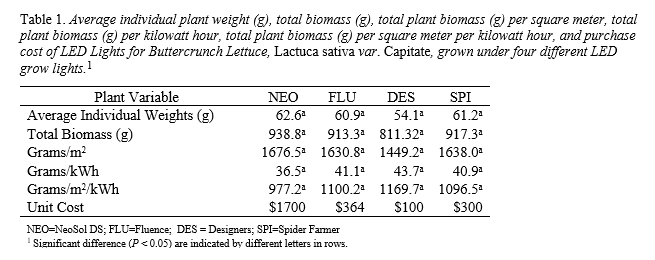EVALUATION OF LOW-COST LED LIGHTS AS THE SOLE SOURCE LIGHT FOR PRODUCTION OF BIBB LETTUCE Lactuca sativa var. Capitate IN INDOOR AQUAPONIC SYSTEMS USING NILE TILAPIA Oreochromis niloticus
For aquaponics producers in northerly latitudes, or indoors in urban settings, artificial light is required for plant growth. Previous studies at Kentucky State University compared several technologies of grow lights and found that light-emitting diodes (LED) lights were significantly better than fluorescent, induction, or metal halide in terms of average plant weights. While the cost of LED technology is decreasing, specialized grow lights can be cost prohibitive for many producers, especially if a large number are required. To address this, a plant g rowth trial was conducted to compare the effectiveness of readily available and inexpensive LED lights to the more expensive horticultural LED lights on the production of Buttercrunch lettuce , Lactuca sativa var. Capitate, in aquaponic systems. The four different LED lights evaluated were the Neosol DS control (NEO ; unit cost $1700) and Spider Farmer SF-2000 (SPI ; unit cost $300) , Fluence RAZRx (FLU ; unit cost $364), and Designers Fountain 3500k (DES ; unit cost $300) treatments . Four 1175-L systems were used with all four lights represented in each system in a complete block design. Adult Nile Tilapia, Oreochromis niloticus (586 g) were stocked in each system and fed a floating 32% protein diet at a rate of 60 g/m2 of plant grow space/day . Plants were harvested after two weeks. At harvest, there were no significant differences (P>0.05) among light treatments (Table 1) in terms of average plant weight (g), total plant biomass (g), or plant growth per unit energy (g/m2/kWh). Since energy costs can be >25% of the variable costs in controlled environment aquaponics, the similar plant growth per unit energy (g/m2/kWh) of all three experimental lights compared to the NEO control make them all suitable alternatives. The similar plant growth results combined with a lower purchase price could make the DES a good candidate for a large-scale production trial.
